Rowlinson Knitwear: Analysis of Management Accounting Report
VerifiedAdded on 2020/10/22
|16
|5212
|359
Report
AI Summary
This report provides a comprehensive analysis of management accounting principles and their practical application within Rowlinson Knitwear. It begins with an introduction to management accounting, its importance, and the essential requirements of a management accounting system, including different accounting systems like cost accounting and inventory management. The report then explores various management accounting reporting methods, such as performance reports and budget reports, along with their benefits. The core of the report delves into costing methods, comparing and contrasting absorption costing and marginal costing, and their implications for financial statements and decision-making. Furthermore, the report examines planning tools for budgetary control, evaluating their advantages and disadvantages, and analyzing their application in responding to financial issues. It concludes by discussing how management accounting systems can help resolve financial problems and lead organizations to sustainable success. The report utilizes real-world examples and case studies to illustrate the concepts and provide a practical understanding of management accounting in a business context.
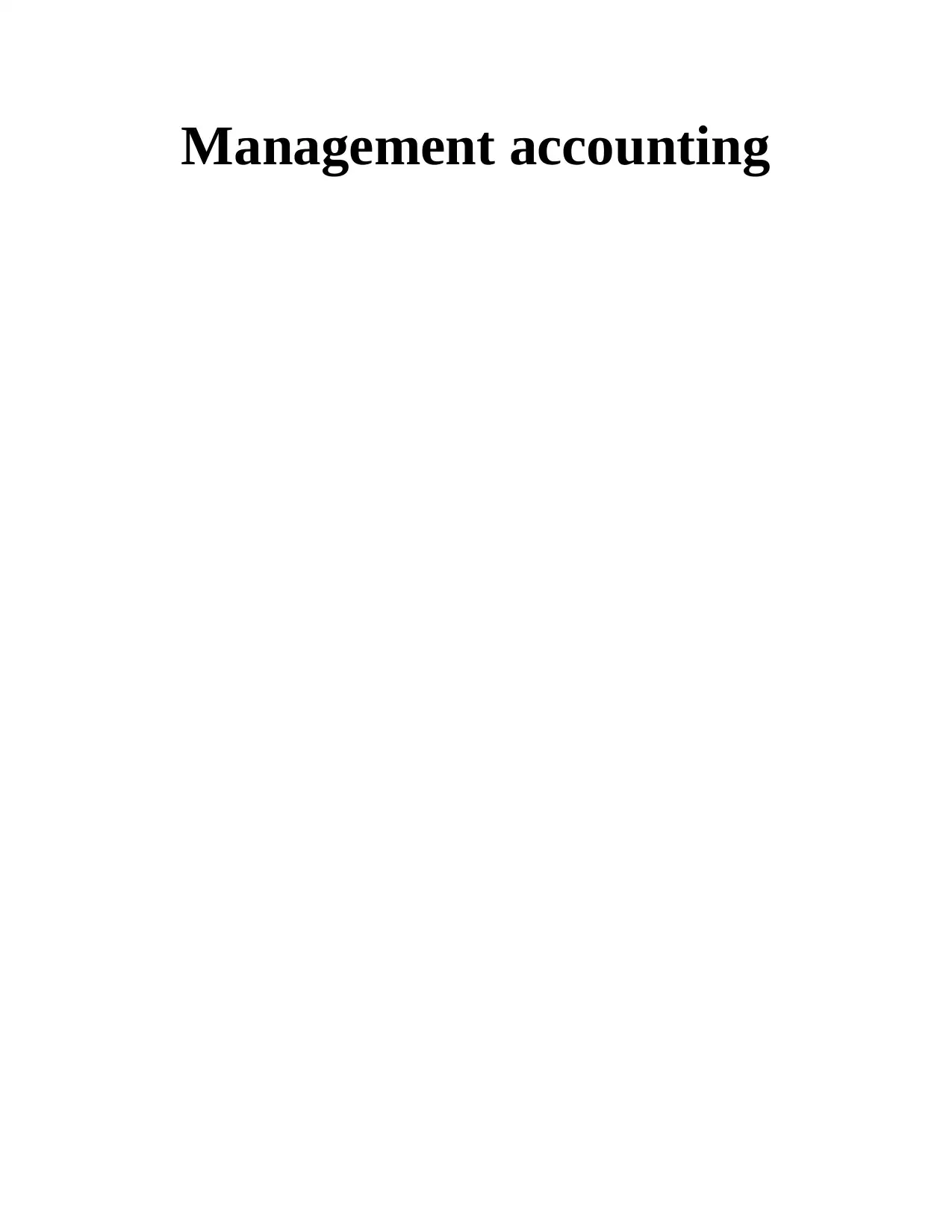
Management accounting
Paraphrase This Document
Need a fresh take? Get an instant paraphrase of this document with our AI Paraphraser
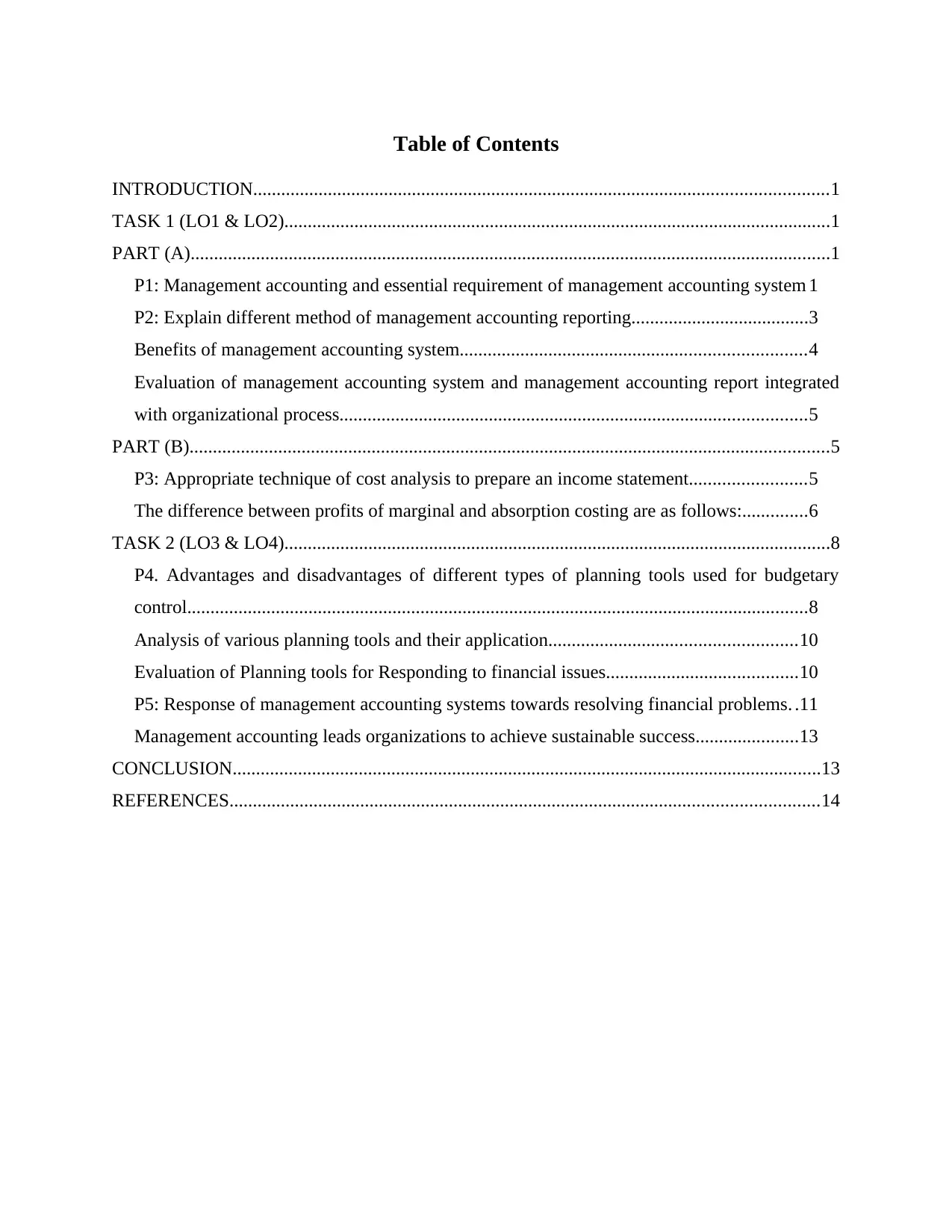
Table of Contents
INTRODUCTION...........................................................................................................................1
TASK 1 (LO1 & LO2).....................................................................................................................1
PART (A).........................................................................................................................................1
P1: Management accounting and essential requirement of management accounting system 1
P2: Explain different method of management accounting reporting......................................3
Benefits of management accounting system..........................................................................4
Evaluation of management accounting system and management accounting report integrated
with organizational process....................................................................................................5
PART (B).........................................................................................................................................5
P3: Appropriate technique of cost analysis to prepare an income statement.........................5
The difference between profits of marginal and absorption costing are as follows:..............6
TASK 2 (LO3 & LO4).....................................................................................................................8
P4. Advantages and disadvantages of different types of planning tools used for budgetary
control.....................................................................................................................................8
Analysis of various planning tools and their application.....................................................10
Evaluation of Planning tools for Responding to financial issues.........................................10
P5: Response of management accounting systems towards resolving financial problems. .11
Management accounting leads organizations to achieve sustainable success......................13
CONCLUSION..............................................................................................................................13
REFERENCES..............................................................................................................................14
INTRODUCTION...........................................................................................................................1
TASK 1 (LO1 & LO2).....................................................................................................................1
PART (A).........................................................................................................................................1
P1: Management accounting and essential requirement of management accounting system 1
P2: Explain different method of management accounting reporting......................................3
Benefits of management accounting system..........................................................................4
Evaluation of management accounting system and management accounting report integrated
with organizational process....................................................................................................5
PART (B).........................................................................................................................................5
P3: Appropriate technique of cost analysis to prepare an income statement.........................5
The difference between profits of marginal and absorption costing are as follows:..............6
TASK 2 (LO3 & LO4).....................................................................................................................8
P4. Advantages and disadvantages of different types of planning tools used for budgetary
control.....................................................................................................................................8
Analysis of various planning tools and their application.....................................................10
Evaluation of Planning tools for Responding to financial issues.........................................10
P5: Response of management accounting systems towards resolving financial problems. .11
Management accounting leads organizations to achieve sustainable success......................13
CONCLUSION..............................................................................................................................13
REFERENCES..............................................................................................................................14
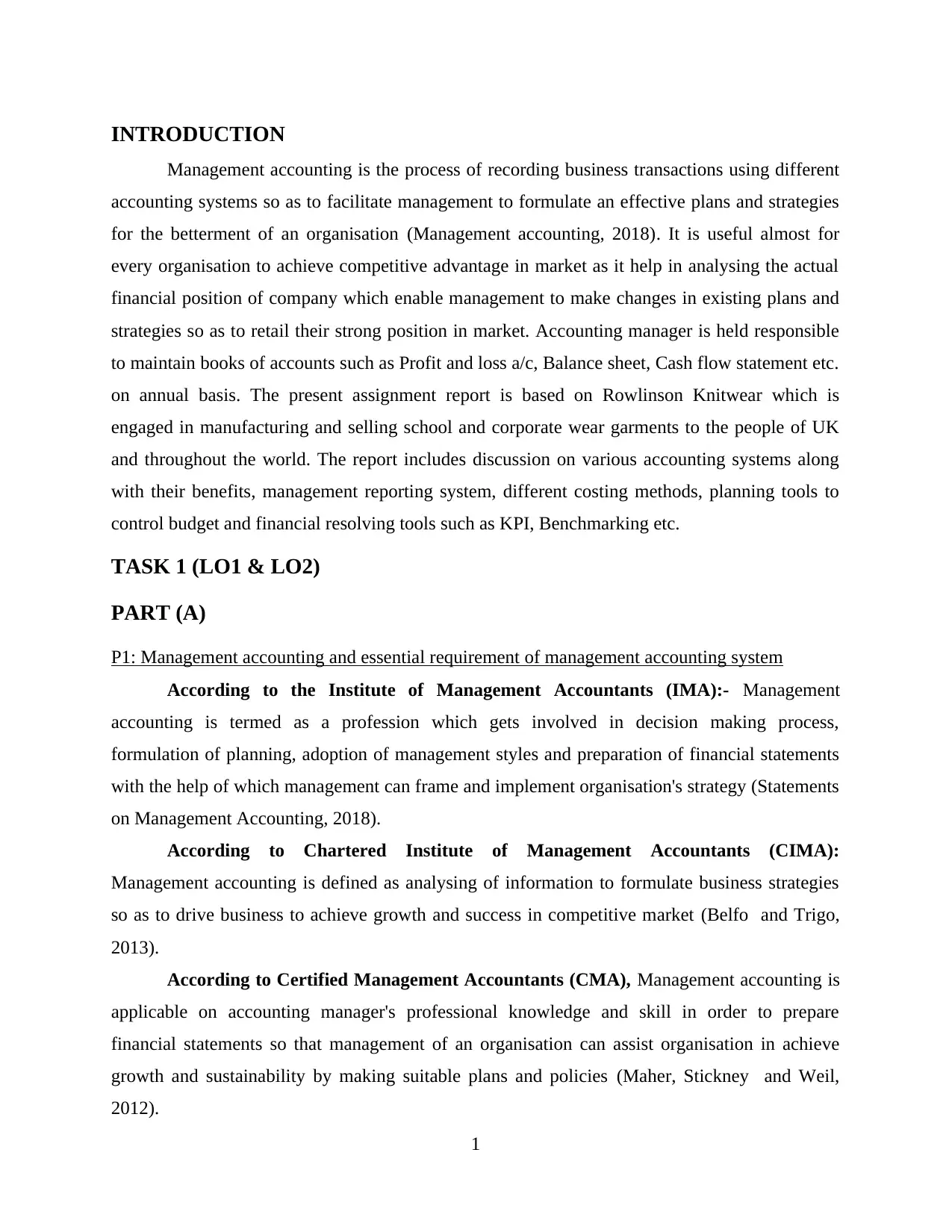
INTRODUCTION
Management accounting is the process of recording business transactions using different
accounting systems so as to facilitate management to formulate an effective plans and strategies
for the betterment of an organisation (Management accounting, 2018). It is useful almost for
every organisation to achieve competitive advantage in market as it help in analysing the actual
financial position of company which enable management to make changes in existing plans and
strategies so as to retail their strong position in market. Accounting manager is held responsible
to maintain books of accounts such as Profit and loss a/c, Balance sheet, Cash flow statement etc.
on annual basis. The present assignment report is based on Rowlinson Knitwear which is
engaged in manufacturing and selling school and corporate wear garments to the people of UK
and throughout the world. The report includes discussion on various accounting systems along
with their benefits, management reporting system, different costing methods, planning tools to
control budget and financial resolving tools such as KPI, Benchmarking etc.
TASK 1 (LO1 & LO2)
PART (A)
P1: Management accounting and essential requirement of management accounting system
According to the Institute of Management Accountants (IMA):- Management
accounting is termed as a profession which gets involved in decision making process,
formulation of planning, adoption of management styles and preparation of financial statements
with the help of which management can frame and implement organisation's strategy (Statements
on Management Accounting, 2018).
According to Chartered Institute of Management Accountants (CIMA):
Management accounting is defined as analysing of information to formulate business strategies
so as to drive business to achieve growth and success in competitive market (Belfo and Trigo,
2013).
According to Certified Management Accountants (CMA), Management accounting is
applicable on accounting manager's professional knowledge and skill in order to prepare
financial statements so that management of an organisation can assist organisation in achieve
growth and sustainability by making suitable plans and policies (Maher, Stickney and Weil,
2012).
1
Management accounting is the process of recording business transactions using different
accounting systems so as to facilitate management to formulate an effective plans and strategies
for the betterment of an organisation (Management accounting, 2018). It is useful almost for
every organisation to achieve competitive advantage in market as it help in analysing the actual
financial position of company which enable management to make changes in existing plans and
strategies so as to retail their strong position in market. Accounting manager is held responsible
to maintain books of accounts such as Profit and loss a/c, Balance sheet, Cash flow statement etc.
on annual basis. The present assignment report is based on Rowlinson Knitwear which is
engaged in manufacturing and selling school and corporate wear garments to the people of UK
and throughout the world. The report includes discussion on various accounting systems along
with their benefits, management reporting system, different costing methods, planning tools to
control budget and financial resolving tools such as KPI, Benchmarking etc.
TASK 1 (LO1 & LO2)
PART (A)
P1: Management accounting and essential requirement of management accounting system
According to the Institute of Management Accountants (IMA):- Management
accounting is termed as a profession which gets involved in decision making process,
formulation of planning, adoption of management styles and preparation of financial statements
with the help of which management can frame and implement organisation's strategy (Statements
on Management Accounting, 2018).
According to Chartered Institute of Management Accountants (CIMA):
Management accounting is defined as analysing of information to formulate business strategies
so as to drive business to achieve growth and success in competitive market (Belfo and Trigo,
2013).
According to Certified Management Accountants (CMA), Management accounting is
applicable on accounting manager's professional knowledge and skill in order to prepare
financial statements so that management of an organisation can assist organisation in achieve
growth and sustainability by making suitable plans and policies (Maher, Stickney and Weil,
2012).
1
⊘ This is a preview!⊘
Do you want full access?
Subscribe today to unlock all pages.

Trusted by 1+ million students worldwide
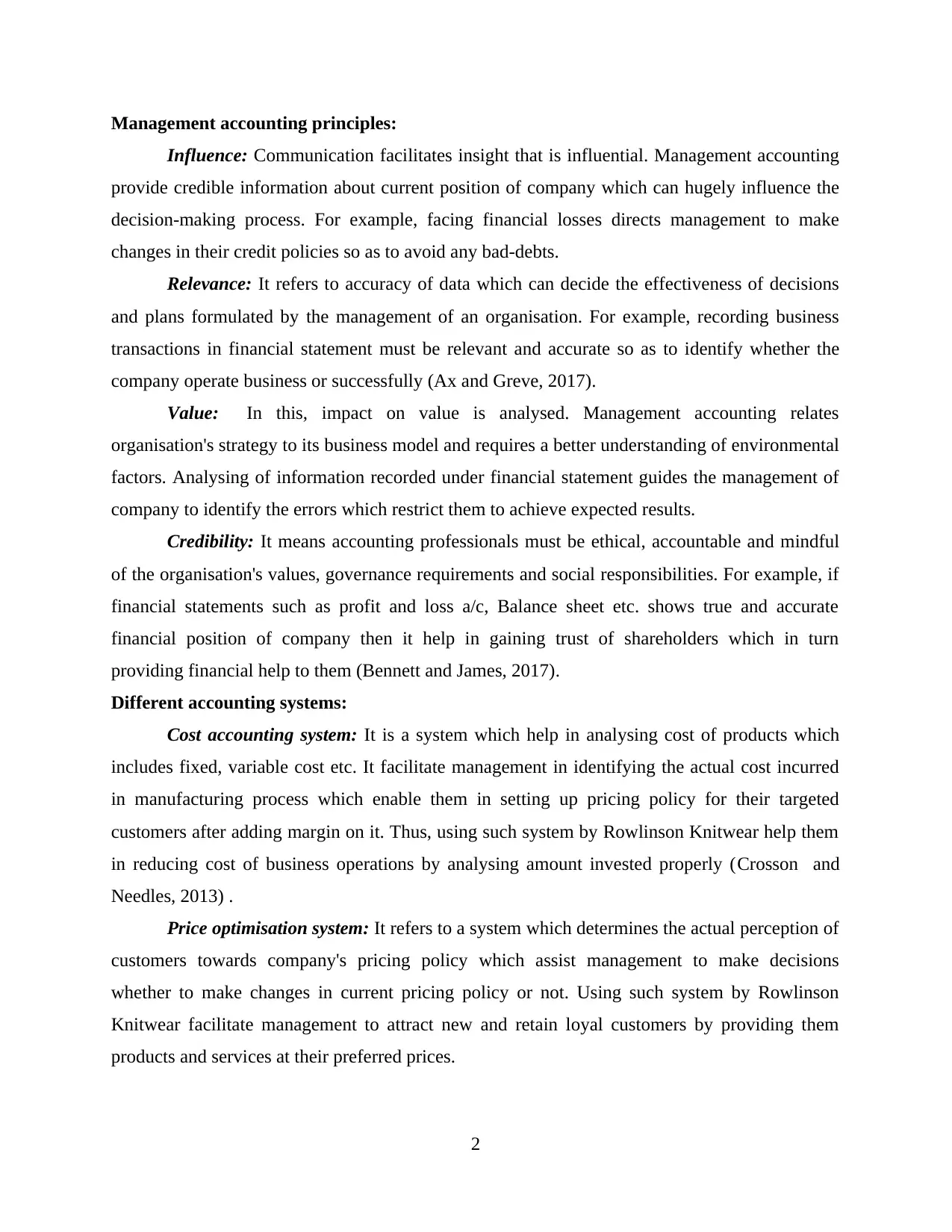
Management accounting principles:
Influence: Communication facilitates insight that is influential. Management accounting
provide credible information about current position of company which can hugely influence the
decision-making process. For example, facing financial losses directs management to make
changes in their credit policies so as to avoid any bad-debts.
Relevance: It refers to accuracy of data which can decide the effectiveness of decisions
and plans formulated by the management of an organisation. For example, recording business
transactions in financial statement must be relevant and accurate so as to identify whether the
company operate business or successfully (Ax and Greve, 2017).
Value: In this, impact on value is analysed. Management accounting relates
organisation's strategy to its business model and requires a better understanding of environmental
factors. Analysing of information recorded under financial statement guides the management of
company to identify the errors which restrict them to achieve expected results.
Credibility: It means accounting professionals must be ethical, accountable and mindful
of the organisation's values, governance requirements and social responsibilities. For example, if
financial statements such as profit and loss a/c, Balance sheet etc. shows true and accurate
financial position of company then it help in gaining trust of shareholders which in turn
providing financial help to them (Bennett and James, 2017).
Different accounting systems:
Cost accounting system: It is a system which help in analysing cost of products which
includes fixed, variable cost etc. It facilitate management in identifying the actual cost incurred
in manufacturing process which enable them in setting up pricing policy for their targeted
customers after adding margin on it. Thus, using such system by Rowlinson Knitwear help them
in reducing cost of business operations by analysing amount invested properly (Crosson and
Needles, 2013) .
Price optimisation system: It refers to a system which determines the actual perception of
customers towards company's pricing policy which assist management to make decisions
whether to make changes in current pricing policy or not. Using such system by Rowlinson
Knitwear facilitate management to attract new and retain loyal customers by providing them
products and services at their preferred prices.
2
Influence: Communication facilitates insight that is influential. Management accounting
provide credible information about current position of company which can hugely influence the
decision-making process. For example, facing financial losses directs management to make
changes in their credit policies so as to avoid any bad-debts.
Relevance: It refers to accuracy of data which can decide the effectiveness of decisions
and plans formulated by the management of an organisation. For example, recording business
transactions in financial statement must be relevant and accurate so as to identify whether the
company operate business or successfully (Ax and Greve, 2017).
Value: In this, impact on value is analysed. Management accounting relates
organisation's strategy to its business model and requires a better understanding of environmental
factors. Analysing of information recorded under financial statement guides the management of
company to identify the errors which restrict them to achieve expected results.
Credibility: It means accounting professionals must be ethical, accountable and mindful
of the organisation's values, governance requirements and social responsibilities. For example, if
financial statements such as profit and loss a/c, Balance sheet etc. shows true and accurate
financial position of company then it help in gaining trust of shareholders which in turn
providing financial help to them (Bennett and James, 2017).
Different accounting systems:
Cost accounting system: It is a system which help in analysing cost of products which
includes fixed, variable cost etc. It facilitate management in identifying the actual cost incurred
in manufacturing process which enable them in setting up pricing policy for their targeted
customers after adding margin on it. Thus, using such system by Rowlinson Knitwear help them
in reducing cost of business operations by analysing amount invested properly (Crosson and
Needles, 2013) .
Price optimisation system: It refers to a system which determines the actual perception of
customers towards company's pricing policy which assist management to make decisions
whether to make changes in current pricing policy or not. Using such system by Rowlinson
Knitwear facilitate management to attract new and retain loyal customers by providing them
products and services at their preferred prices.
2
Paraphrase This Document
Need a fresh take? Get an instant paraphrase of this document with our AI Paraphraser
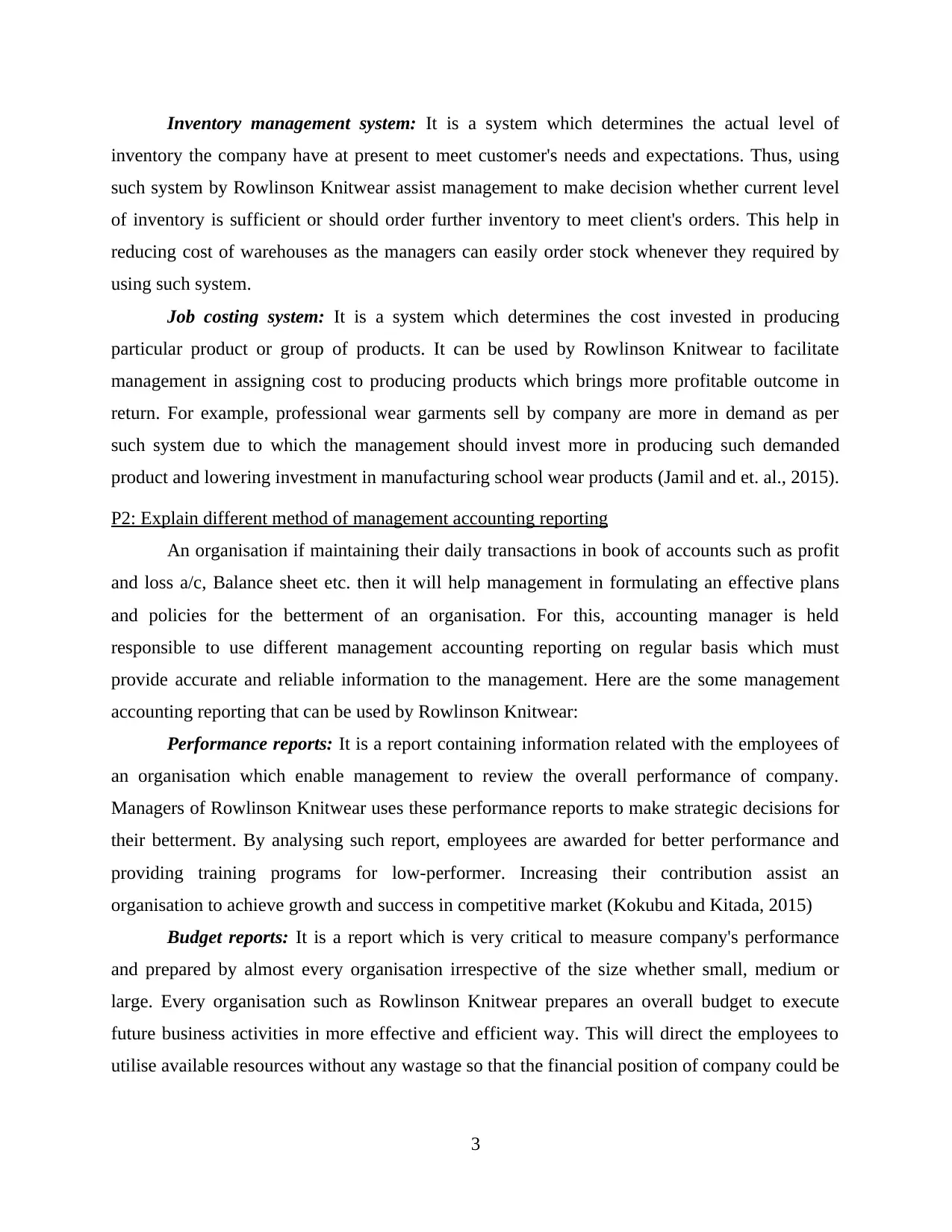
Inventory management system: It is a system which determines the actual level of
inventory the company have at present to meet customer's needs and expectations. Thus, using
such system by Rowlinson Knitwear assist management to make decision whether current level
of inventory is sufficient or should order further inventory to meet client's orders. This help in
reducing cost of warehouses as the managers can easily order stock whenever they required by
using such system.
Job costing system: It is a system which determines the cost invested in producing
particular product or group of products. It can be used by Rowlinson Knitwear to facilitate
management in assigning cost to producing products which brings more profitable outcome in
return. For example, professional wear garments sell by company are more in demand as per
such system due to which the management should invest more in producing such demanded
product and lowering investment in manufacturing school wear products (Jamil and et. al., 2015).
P2: Explain different method of management accounting reporting
An organisation if maintaining their daily transactions in book of accounts such as profit
and loss a/c, Balance sheet etc. then it will help management in formulating an effective plans
and policies for the betterment of an organisation. For this, accounting manager is held
responsible to use different management accounting reporting on regular basis which must
provide accurate and reliable information to the management. Here are the some management
accounting reporting that can be used by Rowlinson Knitwear:
Performance reports: It is a report containing information related with the employees of
an organisation which enable management to review the overall performance of company.
Managers of Rowlinson Knitwear uses these performance reports to make strategic decisions for
their betterment. By analysing such report, employees are awarded for better performance and
providing training programs for low-performer. Increasing their contribution assist an
organisation to achieve growth and success in competitive market (Kokubu and Kitada, 2015)
Budget reports: It is a report which is very critical to measure company's performance
and prepared by almost every organisation irrespective of the size whether small, medium or
large. Every organisation such as Rowlinson Knitwear prepares an overall budget to execute
future business activities in more effective and efficient way. This will direct the employees to
utilise available resources without any wastage so that the financial position of company could be
3
inventory the company have at present to meet customer's needs and expectations. Thus, using
such system by Rowlinson Knitwear assist management to make decision whether current level
of inventory is sufficient or should order further inventory to meet client's orders. This help in
reducing cost of warehouses as the managers can easily order stock whenever they required by
using such system.
Job costing system: It is a system which determines the cost invested in producing
particular product or group of products. It can be used by Rowlinson Knitwear to facilitate
management in assigning cost to producing products which brings more profitable outcome in
return. For example, professional wear garments sell by company are more in demand as per
such system due to which the management should invest more in producing such demanded
product and lowering investment in manufacturing school wear products (Jamil and et. al., 2015).
P2: Explain different method of management accounting reporting
An organisation if maintaining their daily transactions in book of accounts such as profit
and loss a/c, Balance sheet etc. then it will help management in formulating an effective plans
and policies for the betterment of an organisation. For this, accounting manager is held
responsible to use different management accounting reporting on regular basis which must
provide accurate and reliable information to the management. Here are the some management
accounting reporting that can be used by Rowlinson Knitwear:
Performance reports: It is a report containing information related with the employees of
an organisation which enable management to review the overall performance of company.
Managers of Rowlinson Knitwear uses these performance reports to make strategic decisions for
their betterment. By analysing such report, employees are awarded for better performance and
providing training programs for low-performer. Increasing their contribution assist an
organisation to achieve growth and success in competitive market (Kokubu and Kitada, 2015)
Budget reports: It is a report which is very critical to measure company's performance
and prepared by almost every organisation irrespective of the size whether small, medium or
large. Every organisation such as Rowlinson Knitwear prepares an overall budget to execute
future business activities in more effective and efficient way. This will direct the employees to
utilise available resources without any wastage so that the financial position of company could be
3
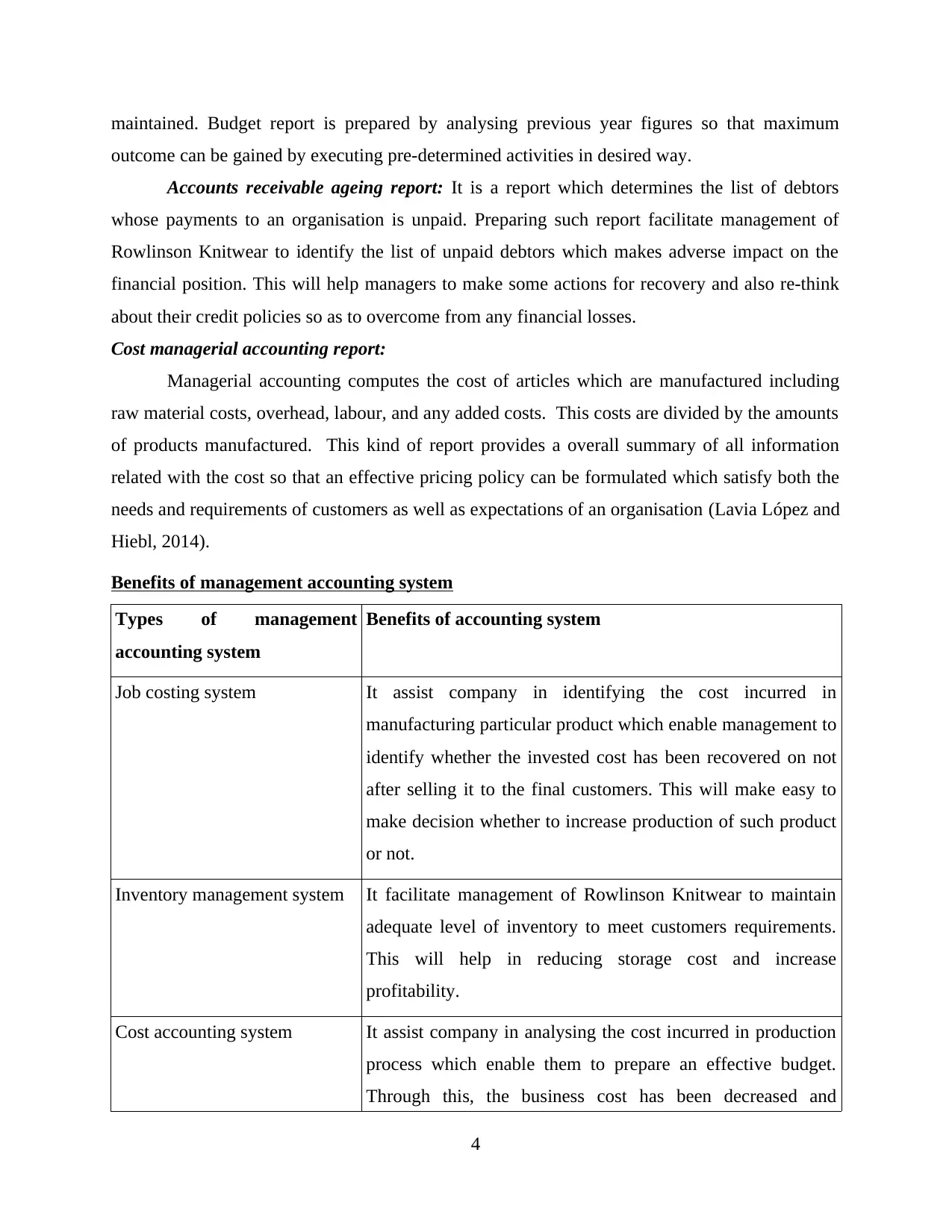
maintained. Budget report is prepared by analysing previous year figures so that maximum
outcome can be gained by executing pre-determined activities in desired way.
Accounts receivable ageing report: It is a report which determines the list of debtors
whose payments to an organisation is unpaid. Preparing such report facilitate management of
Rowlinson Knitwear to identify the list of unpaid debtors which makes adverse impact on the
financial position. This will help managers to make some actions for recovery and also re-think
about their credit policies so as to overcome from any financial losses.
Cost managerial accounting report:
Managerial accounting computes the cost of articles which are manufactured including
raw material costs, overhead, labour, and any added costs. This costs are divided by the amounts
of products manufactured. This kind of report provides a overall summary of all information
related with the cost so that an effective pricing policy can be formulated which satisfy both the
needs and requirements of customers as well as expectations of an organisation (Lavia López and
Hiebl, 2014).
Benefits of management accounting system
Types of management
accounting system
Benefits of accounting system
Job costing system It assist company in identifying the cost incurred in
manufacturing particular product which enable management to
identify whether the invested cost has been recovered on not
after selling it to the final customers. This will make easy to
make decision whether to increase production of such product
or not.
Inventory management system It facilitate management of Rowlinson Knitwear to maintain
adequate level of inventory to meet customers requirements.
This will help in reducing storage cost and increase
profitability.
Cost accounting system It assist company in analysing the cost incurred in production
process which enable them to prepare an effective budget.
Through this, the business cost has been decreased and
4
outcome can be gained by executing pre-determined activities in desired way.
Accounts receivable ageing report: It is a report which determines the list of debtors
whose payments to an organisation is unpaid. Preparing such report facilitate management of
Rowlinson Knitwear to identify the list of unpaid debtors which makes adverse impact on the
financial position. This will help managers to make some actions for recovery and also re-think
about their credit policies so as to overcome from any financial losses.
Cost managerial accounting report:
Managerial accounting computes the cost of articles which are manufactured including
raw material costs, overhead, labour, and any added costs. This costs are divided by the amounts
of products manufactured. This kind of report provides a overall summary of all information
related with the cost so that an effective pricing policy can be formulated which satisfy both the
needs and requirements of customers as well as expectations of an organisation (Lavia López and
Hiebl, 2014).
Benefits of management accounting system
Types of management
accounting system
Benefits of accounting system
Job costing system It assist company in identifying the cost incurred in
manufacturing particular product which enable management to
identify whether the invested cost has been recovered on not
after selling it to the final customers. This will make easy to
make decision whether to increase production of such product
or not.
Inventory management system It facilitate management of Rowlinson Knitwear to maintain
adequate level of inventory to meet customers requirements.
This will help in reducing storage cost and increase
profitability.
Cost accounting system It assist company in analysing the cost incurred in production
process which enable them to prepare an effective budget.
Through this, the business cost has been decreased and
4
⊘ This is a preview!⊘
Do you want full access?
Subscribe today to unlock all pages.

Trusted by 1+ million students worldwide
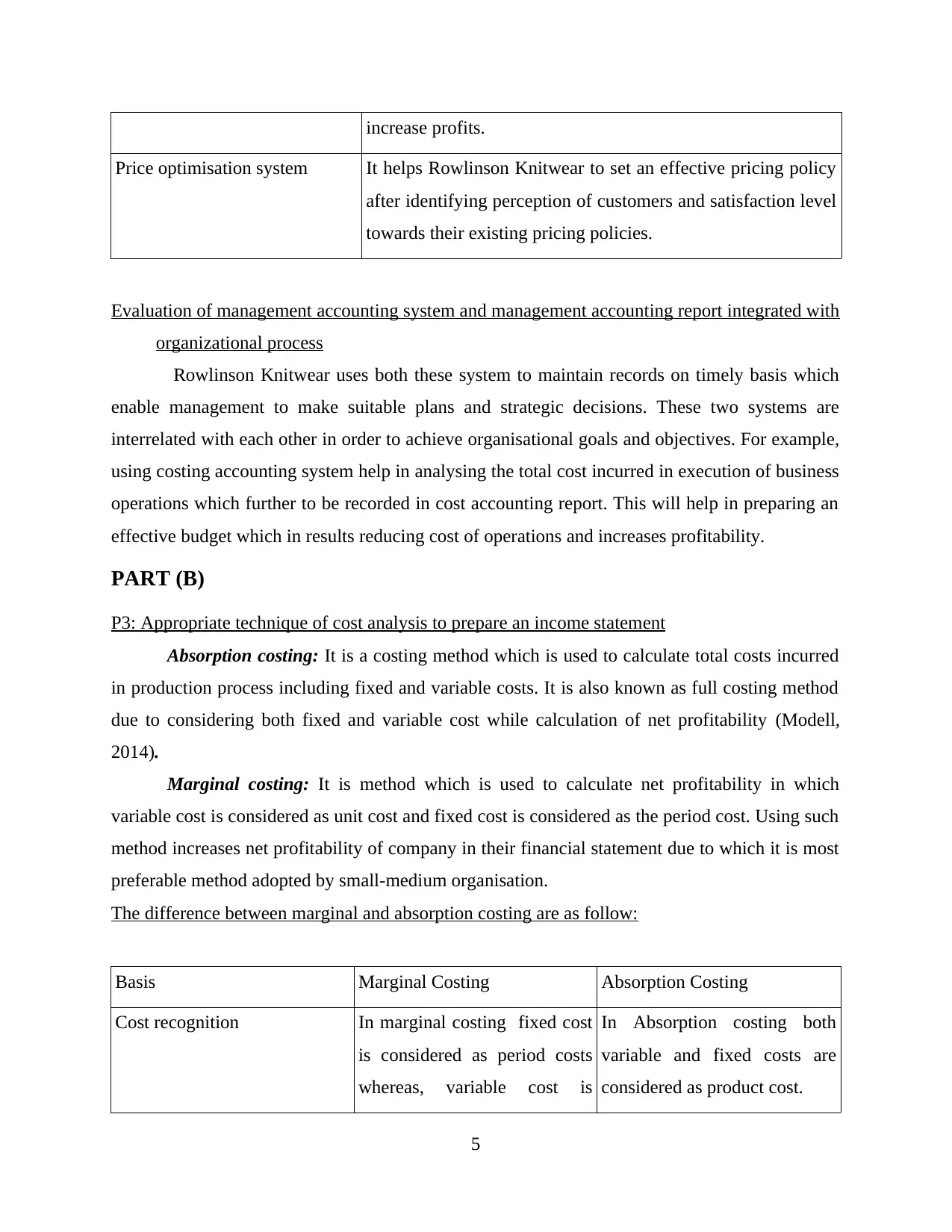
increase profits.
Price optimisation system It helps Rowlinson Knitwear to set an effective pricing policy
after identifying perception of customers and satisfaction level
towards their existing pricing policies.
Evaluation of management accounting system and management accounting report integrated with
organizational process
Rowlinson Knitwear uses both these system to maintain records on timely basis which
enable management to make suitable plans and strategic decisions. These two systems are
interrelated with each other in order to achieve organisational goals and objectives. For example,
using costing accounting system help in analysing the total cost incurred in execution of business
operations which further to be recorded in cost accounting report. This will help in preparing an
effective budget which in results reducing cost of operations and increases profitability.
PART (B)
P3: Appropriate technique of cost analysis to prepare an income statement
Absorption costing: It is a costing method which is used to calculate total costs incurred
in production process including fixed and variable costs. It is also known as full costing method
due to considering both fixed and variable cost while calculation of net profitability (Modell,
2014).
Marginal costing: It is method which is used to calculate net profitability in which
variable cost is considered as unit cost and fixed cost is considered as the period cost. Using such
method increases net profitability of company in their financial statement due to which it is most
preferable method adopted by small-medium organisation.
The difference between marginal and absorption costing are as follow:
Basis Marginal Costing Absorption Costing
Cost recognition In marginal costing fixed cost
is considered as period costs
whereas, variable cost is
In Absorption costing both
variable and fixed costs are
considered as product cost.
5
Price optimisation system It helps Rowlinson Knitwear to set an effective pricing policy
after identifying perception of customers and satisfaction level
towards their existing pricing policies.
Evaluation of management accounting system and management accounting report integrated with
organizational process
Rowlinson Knitwear uses both these system to maintain records on timely basis which
enable management to make suitable plans and strategic decisions. These two systems are
interrelated with each other in order to achieve organisational goals and objectives. For example,
using costing accounting system help in analysing the total cost incurred in execution of business
operations which further to be recorded in cost accounting report. This will help in preparing an
effective budget which in results reducing cost of operations and increases profitability.
PART (B)
P3: Appropriate technique of cost analysis to prepare an income statement
Absorption costing: It is a costing method which is used to calculate total costs incurred
in production process including fixed and variable costs. It is also known as full costing method
due to considering both fixed and variable cost while calculation of net profitability (Modell,
2014).
Marginal costing: It is method which is used to calculate net profitability in which
variable cost is considered as unit cost and fixed cost is considered as the period cost. Using such
method increases net profitability of company in their financial statement due to which it is most
preferable method adopted by small-medium organisation.
The difference between marginal and absorption costing are as follow:
Basis Marginal Costing Absorption Costing
Cost recognition In marginal costing fixed cost
is considered as period costs
whereas, variable cost is
In Absorption costing both
variable and fixed costs are
considered as product cost.
5
Paraphrase This Document
Need a fresh take? Get an instant paraphrase of this document with our AI Paraphraser
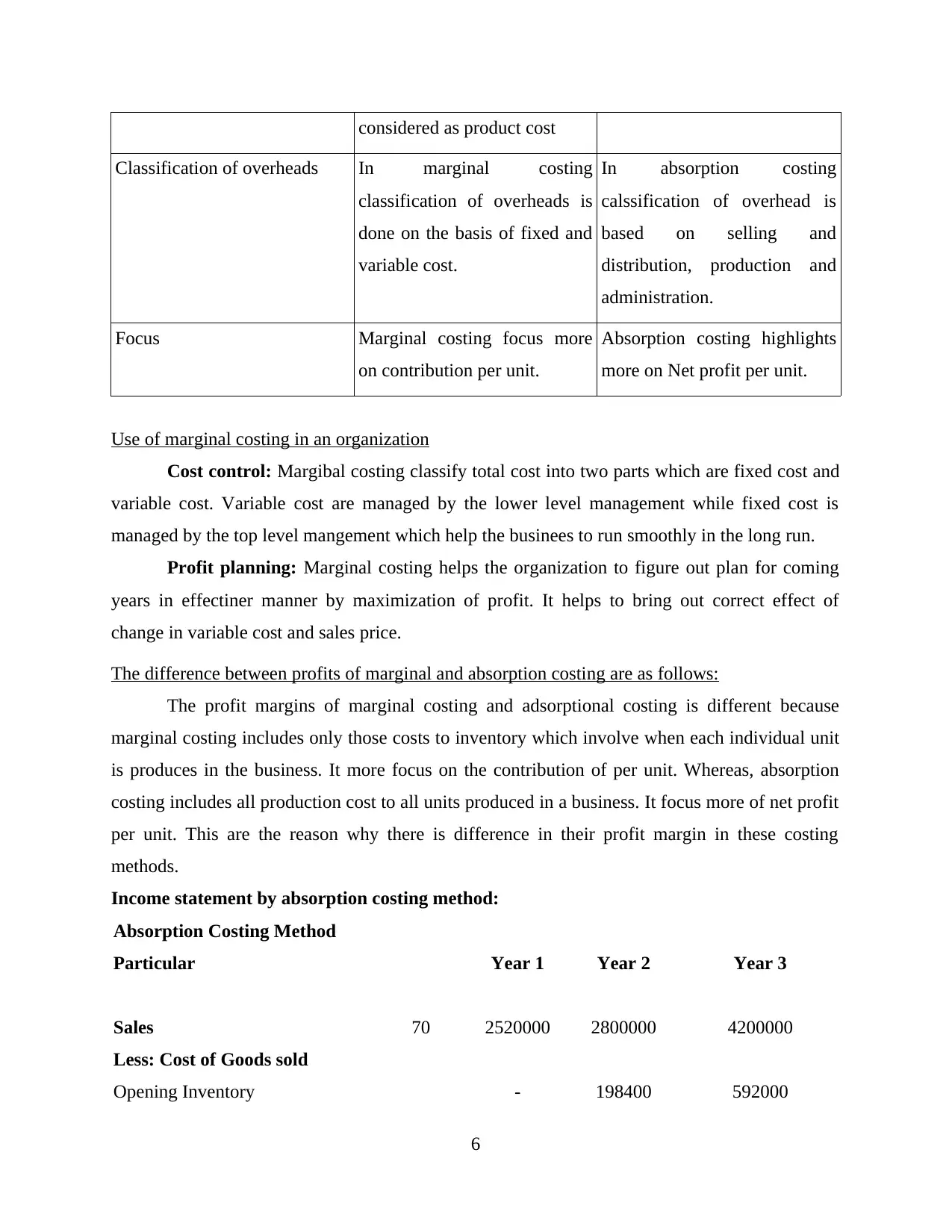
considered as product cost
Classification of overheads In marginal costing
classification of overheads is
done on the basis of fixed and
variable cost.
In absorption costing
calssification of overhead is
based on selling and
distribution, production and
administration.
Focus Marginal costing focus more
on contribution per unit.
Absorption costing highlights
more on Net profit per unit.
Use of marginal costing in an organization
Cost control: Margibal costing classify total cost into two parts which are fixed cost and
variable cost. Variable cost are managed by the lower level management while fixed cost is
managed by the top level mangement which help the businees to run smoothly in the long run.
Profit planning: Marginal costing helps the organization to figure out plan for coming
years in effectiner manner by maximization of profit. It helps to bring out correct effect of
change in variable cost and sales price.
The difference between profits of marginal and absorption costing are as follows:
The profit margins of marginal costing and adsorptional costing is different because
marginal costing includes only those costs to inventory which involve when each individual unit
is produces in the business. It more focus on the contribution of per unit. Whereas, absorption
costing includes all production cost to all units produced in a business. It focus more of net profit
per unit. This are the reason why there is difference in their profit margin in these costing
methods.
Income statement by absorption costing method:
Absorption Costing Method
Particular Year 1 Year 2 Year 3
Sales 70 2520000 2800000 4200000
Less: Cost of Goods sold
Opening Inventory - 198400 592000
6
Classification of overheads In marginal costing
classification of overheads is
done on the basis of fixed and
variable cost.
In absorption costing
calssification of overhead is
based on selling and
distribution, production and
administration.
Focus Marginal costing focus more
on contribution per unit.
Absorption costing highlights
more on Net profit per unit.
Use of marginal costing in an organization
Cost control: Margibal costing classify total cost into two parts which are fixed cost and
variable cost. Variable cost are managed by the lower level management while fixed cost is
managed by the top level mangement which help the businees to run smoothly in the long run.
Profit planning: Marginal costing helps the organization to figure out plan for coming
years in effectiner manner by maximization of profit. It helps to bring out correct effect of
change in variable cost and sales price.
The difference between profits of marginal and absorption costing are as follows:
The profit margins of marginal costing and adsorptional costing is different because
marginal costing includes only those costs to inventory which involve when each individual unit
is produces in the business. It more focus on the contribution of per unit. Whereas, absorption
costing includes all production cost to all units produced in a business. It focus more of net profit
per unit. This are the reason why there is difference in their profit margin in these costing
methods.
Income statement by absorption costing method:
Absorption Costing Method
Particular Year 1 Year 2 Year 3
Sales 70 2520000 2800000 4200000
Less: Cost of Goods sold
Opening Inventory - 198400 592000
6
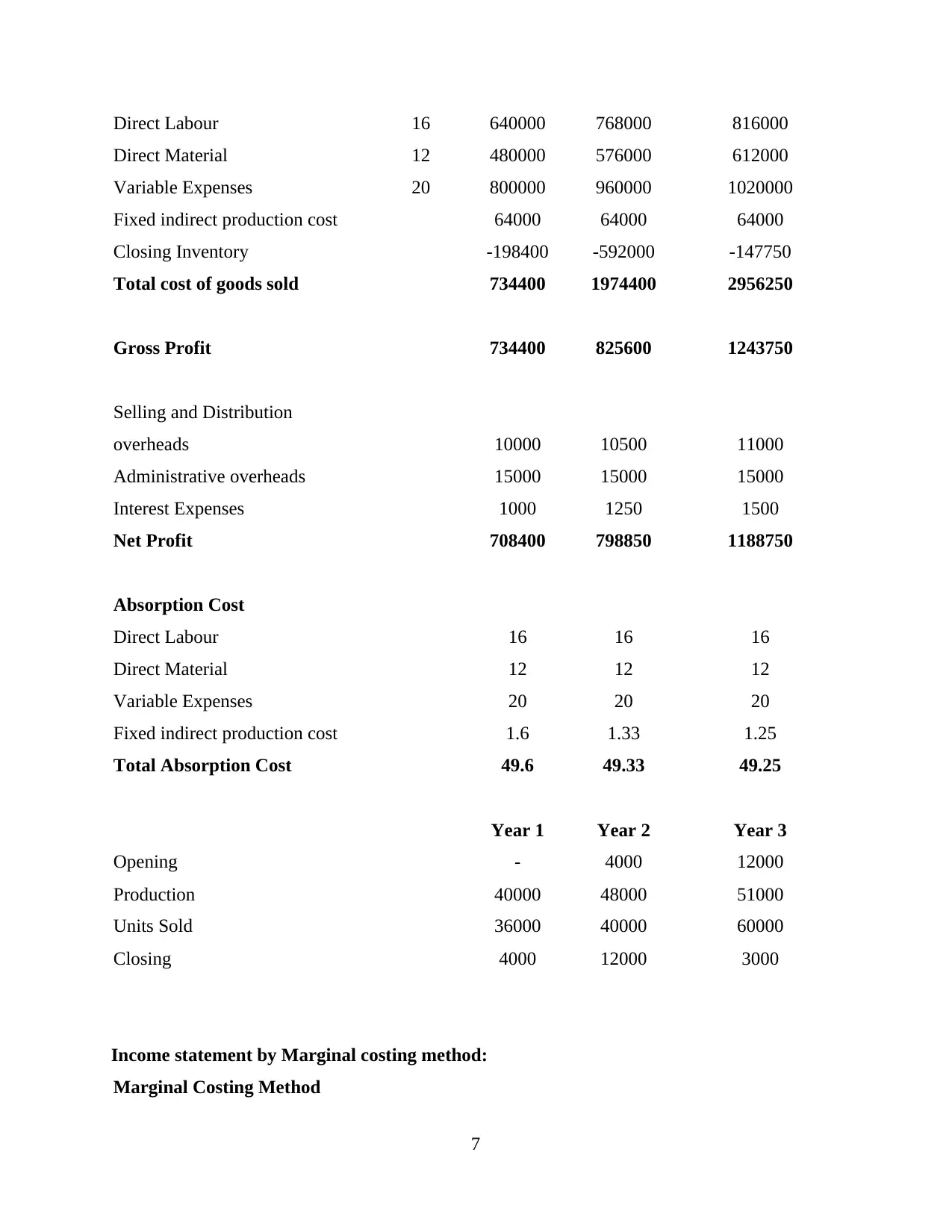
Direct Labour 16 640000 768000 816000
Direct Material 12 480000 576000 612000
Variable Expenses 20 800000 960000 1020000
Fixed indirect production cost 64000 64000 64000
Closing Inventory -198400 -592000 -147750
Total cost of goods sold 734400 1974400 2956250
Gross Profit 734400 825600 1243750
Selling and Distribution
overheads 10000 10500 11000
Administrative overheads 15000 15000 15000
Interest Expenses 1000 1250 1500
Net Profit 708400 798850 1188750
Absorption Cost
Direct Labour 16 16 16
Direct Material 12 12 12
Variable Expenses 20 20 20
Fixed indirect production cost 1.6 1.33 1.25
Total Absorption Cost 49.6 49.33 49.25
Year 1 Year 2 Year 3
Opening - 4000 12000
Production 40000 48000 51000
Units Sold 36000 40000 60000
Closing 4000 12000 3000
Income statement by Marginal costing method:
Marginal Costing Method
7
Direct Material 12 480000 576000 612000
Variable Expenses 20 800000 960000 1020000
Fixed indirect production cost 64000 64000 64000
Closing Inventory -198400 -592000 -147750
Total cost of goods sold 734400 1974400 2956250
Gross Profit 734400 825600 1243750
Selling and Distribution
overheads 10000 10500 11000
Administrative overheads 15000 15000 15000
Interest Expenses 1000 1250 1500
Net Profit 708400 798850 1188750
Absorption Cost
Direct Labour 16 16 16
Direct Material 12 12 12
Variable Expenses 20 20 20
Fixed indirect production cost 1.6 1.33 1.25
Total Absorption Cost 49.6 49.33 49.25
Year 1 Year 2 Year 3
Opening - 4000 12000
Production 40000 48000 51000
Units Sold 36000 40000 60000
Closing 4000 12000 3000
Income statement by Marginal costing method:
Marginal Costing Method
7
⊘ This is a preview!⊘
Do you want full access?
Subscribe today to unlock all pages.

Trusted by 1+ million students worldwide
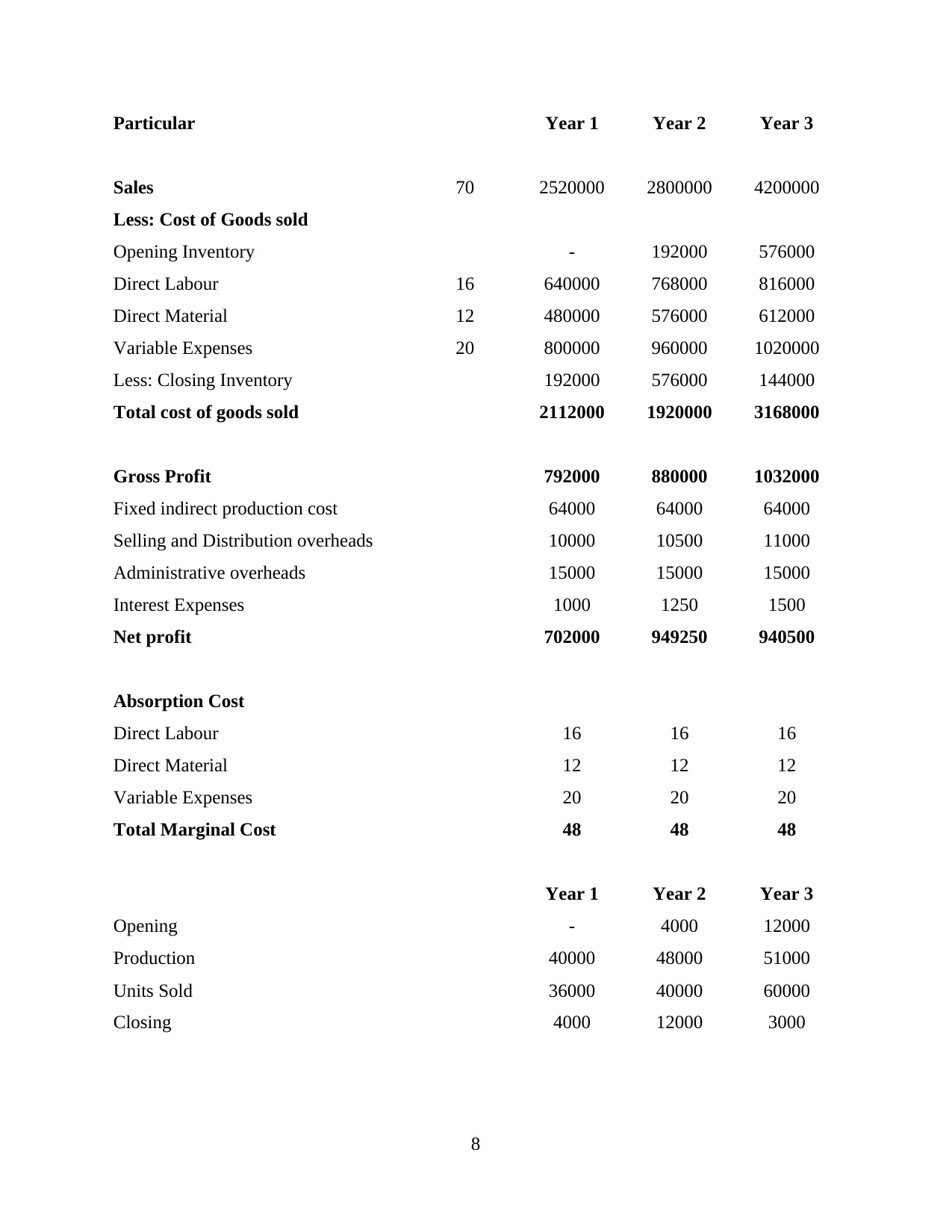
Particular Year 1 Year 2 Year 3
Sales 70 2520000 2800000 4200000
Less: Cost of Goods sold
Opening Inventory - 192000 576000
Direct Labour 16 640000 768000 816000
Direct Material 12 480000 576000 612000
Variable Expenses 20 800000 960000 1020000
Less: Closing Inventory 192000 576000 144000
Total cost of goods sold 2112000 1920000 3168000
Gross Profit 792000 880000 1032000
Fixed indirect production cost 64000 64000 64000
Selling and Distribution overheads 10000 10500 11000
Administrative overheads 15000 15000 15000
Interest Expenses 1000 1250 1500
Net profit 702000 949250 940500
Absorption Cost
Direct Labour 16 16 16
Direct Material 12 12 12
Variable Expenses 20 20 20
Total Marginal Cost 48 48 48
Year 1 Year 2 Year 3
Opening - 4000 12000
Production 40000 48000 51000
Units Sold 36000 40000 60000
Closing 4000 12000 3000
8
Sales 70 2520000 2800000 4200000
Less: Cost of Goods sold
Opening Inventory - 192000 576000
Direct Labour 16 640000 768000 816000
Direct Material 12 480000 576000 612000
Variable Expenses 20 800000 960000 1020000
Less: Closing Inventory 192000 576000 144000
Total cost of goods sold 2112000 1920000 3168000
Gross Profit 792000 880000 1032000
Fixed indirect production cost 64000 64000 64000
Selling and Distribution overheads 10000 10500 11000
Administrative overheads 15000 15000 15000
Interest Expenses 1000 1250 1500
Net profit 702000 949250 940500
Absorption Cost
Direct Labour 16 16 16
Direct Material 12 12 12
Variable Expenses 20 20 20
Total Marginal Cost 48 48 48
Year 1 Year 2 Year 3
Opening - 4000 12000
Production 40000 48000 51000
Units Sold 36000 40000 60000
Closing 4000 12000 3000
8
Paraphrase This Document
Need a fresh take? Get an instant paraphrase of this document with our AI Paraphraser
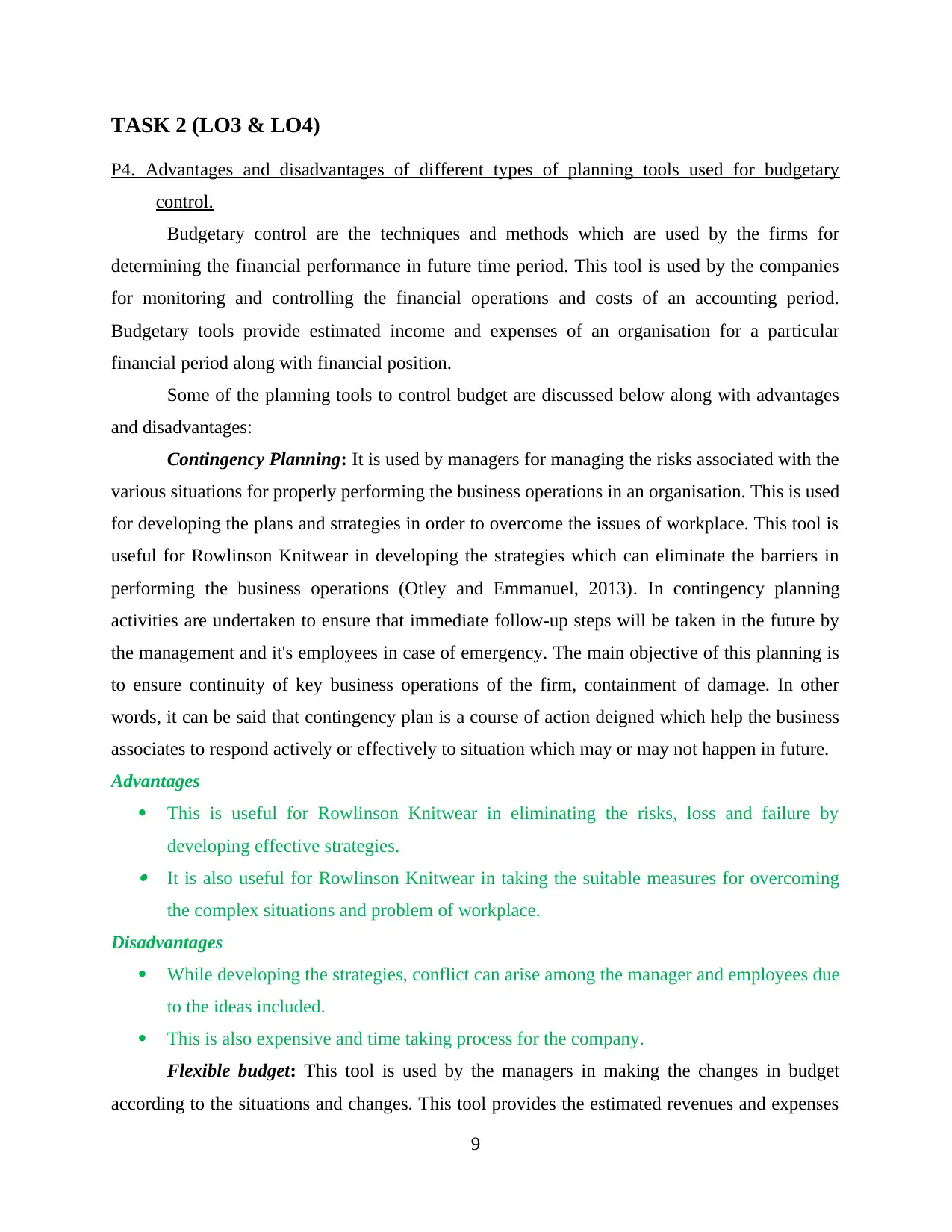
TASK 2 (LO3 & LO4)
P4. Advantages and disadvantages of different types of planning tools used for budgetary
control.
Budgetary control are the techniques and methods which are used by the firms for
determining the financial performance in future time period. This tool is used by the companies
for monitoring and controlling the financial operations and costs of an accounting period.
Budgetary tools provide estimated income and expenses of an organisation for a particular
financial period along with financial position.
Some of the planning tools to control budget are discussed below along with advantages
and disadvantages:
Contingency Planning: It is used by managers for managing the risks associated with the
various situations for properly performing the business operations in an organisation. This is used
for developing the plans and strategies in order to overcome the issues of workplace. This tool is
useful for Rowlinson Knitwear in developing the strategies which can eliminate the barriers in
performing the business operations (Otley and Emmanuel, 2013). In contingency planning
activities are undertaken to ensure that immediate follow-up steps will be taken in the future by
the management and it's employees in case of emergency. The main objective of this planning is
to ensure continuity of key business operations of the firm, containment of damage. In other
words, it can be said that contingency plan is a course of action deigned which help the business
associates to respond actively or effectively to situation which may or may not happen in future.
Advantages
This is useful for Rowlinson Knitwear in eliminating the risks, loss and failure by
developing effective strategies. It is also useful for Rowlinson Knitwear in taking the suitable measures for overcoming
the complex situations and problem of workplace.
Disadvantages
While developing the strategies, conflict can arise among the manager and employees due
to the ideas included.
This is also expensive and time taking process for the company.
Flexible budget: This tool is used by the managers in making the changes in budget
according to the situations and changes. This tool provides the estimated revenues and expenses
9
P4. Advantages and disadvantages of different types of planning tools used for budgetary
control.
Budgetary control are the techniques and methods which are used by the firms for
determining the financial performance in future time period. This tool is used by the companies
for monitoring and controlling the financial operations and costs of an accounting period.
Budgetary tools provide estimated income and expenses of an organisation for a particular
financial period along with financial position.
Some of the planning tools to control budget are discussed below along with advantages
and disadvantages:
Contingency Planning: It is used by managers for managing the risks associated with the
various situations for properly performing the business operations in an organisation. This is used
for developing the plans and strategies in order to overcome the issues of workplace. This tool is
useful for Rowlinson Knitwear in developing the strategies which can eliminate the barriers in
performing the business operations (Otley and Emmanuel, 2013). In contingency planning
activities are undertaken to ensure that immediate follow-up steps will be taken in the future by
the management and it's employees in case of emergency. The main objective of this planning is
to ensure continuity of key business operations of the firm, containment of damage. In other
words, it can be said that contingency plan is a course of action deigned which help the business
associates to respond actively or effectively to situation which may or may not happen in future.
Advantages
This is useful for Rowlinson Knitwear in eliminating the risks, loss and failure by
developing effective strategies. It is also useful for Rowlinson Knitwear in taking the suitable measures for overcoming
the complex situations and problem of workplace.
Disadvantages
While developing the strategies, conflict can arise among the manager and employees due
to the ideas included.
This is also expensive and time taking process for the company.
Flexible budget: This tool is used by the managers in making the changes in budget
according to the situations and changes. This tool provides the estimated revenues and expenses
9
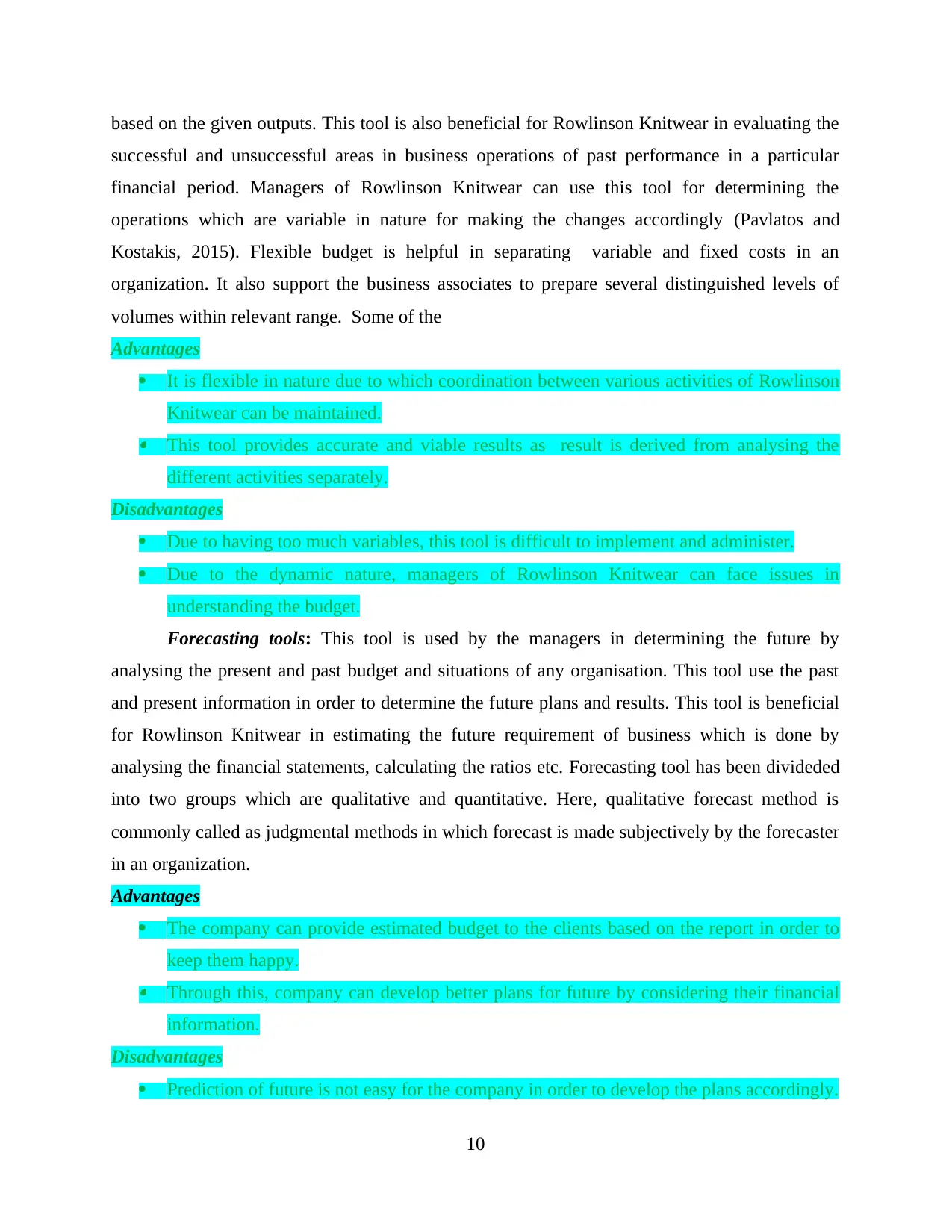
based on the given outputs. This tool is also beneficial for Rowlinson Knitwear in evaluating the
successful and unsuccessful areas in business operations of past performance in a particular
financial period. Managers of Rowlinson Knitwear can use this tool for determining the
operations which are variable in nature for making the changes accordingly (Pavlatos and
Kostakis, 2015). Flexible budget is helpful in separating variable and fixed costs in an
organization. It also support the business associates to prepare several distinguished levels of
volumes within relevant range. Some of the
Advantages
It is flexible in nature due to which coordination between various activities of Rowlinson
Knitwear can be maintained. This tool provides accurate and viable results as result is derived from analysing the
different activities separately.
Disadvantages
Due to having too much variables, this tool is difficult to implement and administer.
Due to the dynamic nature, managers of Rowlinson Knitwear can face issues in
understanding the budget.
Forecasting tools: This tool is used by the managers in determining the future by
analysing the present and past budget and situations of any organisation. This tool use the past
and present information in order to determine the future plans and results. This tool is beneficial
for Rowlinson Knitwear in estimating the future requirement of business which is done by
analysing the financial statements, calculating the ratios etc. Forecasting tool has been divideded
into two groups which are qualitative and quantitative. Here, qualitative forecast method is
commonly called as judgmental methods in which forecast is made subjectively by the forecaster
in an organization.
Advantages
The company can provide estimated budget to the clients based on the report in order to
keep them happy. Through this, company can develop better plans for future by considering their financial
information.
Disadvantages
Prediction of future is not easy for the company in order to develop the plans accordingly.
10
successful and unsuccessful areas in business operations of past performance in a particular
financial period. Managers of Rowlinson Knitwear can use this tool for determining the
operations which are variable in nature for making the changes accordingly (Pavlatos and
Kostakis, 2015). Flexible budget is helpful in separating variable and fixed costs in an
organization. It also support the business associates to prepare several distinguished levels of
volumes within relevant range. Some of the
Advantages
It is flexible in nature due to which coordination between various activities of Rowlinson
Knitwear can be maintained. This tool provides accurate and viable results as result is derived from analysing the
different activities separately.
Disadvantages
Due to having too much variables, this tool is difficult to implement and administer.
Due to the dynamic nature, managers of Rowlinson Knitwear can face issues in
understanding the budget.
Forecasting tools: This tool is used by the managers in determining the future by
analysing the present and past budget and situations of any organisation. This tool use the past
and present information in order to determine the future plans and results. This tool is beneficial
for Rowlinson Knitwear in estimating the future requirement of business which is done by
analysing the financial statements, calculating the ratios etc. Forecasting tool has been divideded
into two groups which are qualitative and quantitative. Here, qualitative forecast method is
commonly called as judgmental methods in which forecast is made subjectively by the forecaster
in an organization.
Advantages
The company can provide estimated budget to the clients based on the report in order to
keep them happy. Through this, company can develop better plans for future by considering their financial
information.
Disadvantages
Prediction of future is not easy for the company in order to develop the plans accordingly.
10
⊘ This is a preview!⊘
Do you want full access?
Subscribe today to unlock all pages.

Trusted by 1+ million students worldwide
1 out of 16
Related Documents
Your All-in-One AI-Powered Toolkit for Academic Success.
+13062052269
info@desklib.com
Available 24*7 on WhatsApp / Email
![[object Object]](/_next/static/media/star-bottom.7253800d.svg)
Unlock your academic potential
Copyright © 2020–2025 A2Z Services. All Rights Reserved. Developed and managed by ZUCOL.





